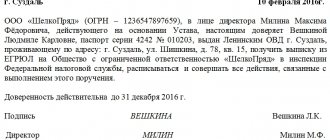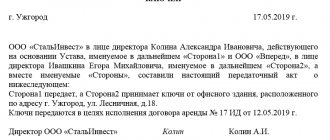Why do you need to make an inventory of transferred documents?
An inventory of documents is necessary to record the fact of their transfer to the addressee, which can be either a government authority (IFTS, court, etc.) or a counterparty under the contract.
Drawing up an inventory is usually resorted to in situations where it is required to transfer not just one document (application, claim, certificate, etc.), but a certain set or set of documentation. Exchange legally significant “primary data” with counterparties via the Internet. Free inbox.
The inventory is most widespread when working with traditional paper documents. However, it is possible to compile an inventory when sending information electronically. Especially if this happens via regular email.
Standards for compiling an inventory of documents
There are no uniform legal requirements for compiling an inventory of documents. Therefore, depending on the purpose of submitting documentation, both unified forms (for example, when sending registered letters) and those developed by the receiving or transmitting party independently can be used.
In any case, the inventory must contain information about the type (name, details) of each of the transferred documents (for example, purchase and sale agreement No. 1 or personal income tax declaration for 2021) and the number of copies. Additionally, if necessary, other information may be indicated - about the number of sheets of each copy of the document, the total number of sheets of all documents specified in the inventory, recipients, reasons for transfer, etc.
List of documents to be submitted to the tax office
When communicating with the tax authority, it is only necessary to draw up an inventory if the documents are transmitted in classic paper form. The legislation does not establish requirements for the form of such an inventory. Therefore, it can be compiled in any form. Moreover, the inventory can be drawn up as a separate document or included as part of a cover letter (clause 6 of Appendix No. 18 to the Order of the Federal Tax Service of Russia dated November 7, 2018 No. MMV-7-2 / [email protected] ).
ATTENTION
When sending documentation to the Federal Tax Service in electronic form, there is no need to create an inventory, because The composition of the documents in this case is recorded automatically by the corresponding software.
Request a tax reconciliation report from the Federal Tax Service via the Internet Request for free
As for the contents of the inventory, it is advisable to reflect not only data on the documents being transferred (date, number, name, number of sheets and copies), but also information regarding the reasons for their transfer, as well as the sender and addressee. Thus, this inventory will additionally contain the details of the organization (IP) transferring the documents, as well as the number and date of the request or other document from the Federal Tax Service, in connection with which the documentation specified in the inventory is provided. It would not be amiss to number the documents being submitted in the inventory, and not just provide a list of them.
Such preparation of the inventory will help, in the event of any further claims from the Federal Tax Service (or questions during the consideration of the dispute in court), to quickly navigate the composition of the transferred documents and promptly submit the necessary explanations or objections.
Delivery list of documentation
This is a special type of accompanying documentation compiled in connection with the transfer of the case to the archive. These lists contain additional columns:
- deadline dates - you must indicate until what date the paper should be stored. The date is determined in accordance with the archival storage norm, as a rule, it is five years;
- shelf life.
We recommend making an inventory of the documents being transferred and filling it out according to the template.
Inventory of documents for transfer to the archive
When transferring documents to the archive for each case, an internal inventory of the documents included in it is compiled. The form of such an inventory is given in Appendix No. 27 to the rules, which were approved by order of the Ministry of Culture of Russia dated 03/31/15 No. 526. And the procedure for its preparation is described in sufficient detail in clause 3.6.17 of the Rules for the work of archives of organizations (approved by the decision of the Board of the Russian Archive dated 02/06/02 ).
In particular, it is indicated that the inventory must be drawn up on a separate sheet and signed by the compiler. The internal inventory contains information about the serial numbers of the case documents, their indexes, dates, headings and sheet numbers of the case. And at the end of the inventory there should be a final record, which indicates in numbers and in words the number of documents included in it and the number of sheets of the internal inventory. In this case, the specific content of documents in the “archival” inventory is not required to be disclosed. Since documents of the same type are placed in the case, a heading (name of the counterparty, full name of the employee, etc.) is sufficient.
Legislative justification
The documentation inventory is carried out on the basis of these instructions:
- Recommendations for office work, approved by Rosarkhiv on December 23, 2009.
- Instructions for office work, approved by the Order of the Ministry of Culture.
- Central Bank instructions.
Documents reflected in the inventory must be properly systematized. First, papers of priority importance (orders, instructions) are recorded, followed by plans, correspondence and other documents.
Inventory of documents for transfer to another organization
The legislator has not established any special rules for preparing an inventory when transferring documents to a counterparty. Therefore, if the specific form of the inventory is not separately agreed upon by the parties (for example, as an annex to the contract), then it can be drawn up in free form. The main requirement is that the inventory must make it clear what, in what quantity, when, in connection with what, from whom and to whom it was transferred.
As in the case of the “tax” inventory, in addition to the actual details of the transferred documentation, it is worth supplementing the inventory with data on the grounds for the transfer (for example, making a reference to a clause in the agreement or correspondence), as well as an indication of the transferring and receiving parties. To certify the inventory, you must indicate your full name, position, affix the signature of the compiler and the date of compilation.
Main purpose
Understanding how to create an inventory of documents allows you to establish an organization’s internal records management, which is necessary to control document flow:
- track the movement of documents between departments or outside the company and at any time determine the current location of the document you are looking for;
- optimize the work of the company and a corresponding reduction in resources, both temporary and human, which are spent on searching for the necessary data or restoring lost data.
Each company has the right to independently determine how to organize the movement of documentation, how to make transfer lists and what type they should have. There are no regulatory requirements in this part; there is a recommended form for an inventory of documents for transfer, which you can rely on when developing your own forms.
List of documents to be sent by Russian Post
The document inventory form, which is used when sending registered postal items with declared value, is given in Appendix No. 26 to the procedure for receiving and delivering internal registered postal items (approved order of the Federal State Unitary Enterprise "Russian Post" dated 03/07/19 No. 98-p). As clause 6.1.1.1 of the procedure states, when sending documents in the inventory according to f. 107 indicates their name and, if necessary, details, as well as the number of sheets in each document. Next, each document must be assigned a valuation amount in full rubles (i.e., at least 1 ruble). After this, the overall total of both the number of sheets sent and the assessment amount is displayed.
IMPORTANT
Inventory according to f.
107 is filled out in 2 copies, each of which is signed by the sender. If the number of documents being sent is such that there are not enough lines on the inventory form, then additional forms must be used. In this case, the first one is marked “sheet 1”, the second one is marked “sheet 2”, etc. Accordingly, the total of the number of sheets and the amount of assessment is summarized only on the last sheet of the inventory. But the sender’s signature must be on each of them.
Conducting an examination of the value of documents
Examination of the value of documents (EDS)
– study of documents based on criteria of their value to determine the storage period for documents*.
To organize and conduct EDS, a permanent expert commission (EC) is created. In large organizations, in addition to the EC, central expert commissions (CEC) are created. They provide methodological support to the EC in their work.
The main functions of the EC are:
- organizing an annual selection of cases for storage and destruction;
- review and approval of draft nomenclature of the organization’s files, inventories of permanent and temporary (over 10 years) storage, including personnel, acts on the allocation for destruction of files that are not subject to storage;
- preparation of proposals to change the storage periods for documents not provided for in the lists, and to change the storage periods for certain categories of documents established by the lists;
- participation in the preparation and consideration of draft regulatory and methodological documents on issues of working with documents in the organization;
- methodological guidance of work in the field of ensuring the safety of the organization's documentary and archival funds.
These commissions can cooperate with expert verification commissions (EPC) of the archival institution to which the organization’s documents will be transferred. Such cooperation is mandatory if the organization is the source of acquisition of the Archival Fund of the Russian Federation. The EC includes 35 of the most qualified employees of the organization and, without fail, the person responsible for the archive.
The chairman of the EC is one of the deputy heads of the organization.
Every year, when carrying out EDS in structural divisions, the following is carried out:
- selection of cases of permanent and temporary (over 10 years) storage for transfer to the archive;
- selection of cases with temporary storage periods (up to 10 years) to be stored in structural units;
- allocation for destruction of files for previous years whose storage periods have expired.
“1C:Document Flow” implements the function of selecting cases for transfer to the archive and for selecting cases for destruction.
The storage periods for files are determined by lists of documents indicating their storage periods and by the nomenclature of the organization’s files.
When selecting documents, special attention should be paid to cases of permanent and temporary (over 10 years) storage. Such cases must be reviewed page by page. This will allow you to identify errors made during the formation of cases.
Based on the results of the electronic digital documentation in the organization, the following are drawn up:
- inventory of permanent storage files;
- inventory of temporary (over 10 years) storage cases;
- inventory of personnel cases;
- acts on the allocation for destruction of files that are not subject to storage.
Documents in electronic form are included in independent inventories.
Inventories and acts are considered at a meeting of the organization's EC at the same time, approved by the head of the organization after approval of the EPC of the archival institution (if necessary). After this, the organization has the right to destroy the files included in these acts.
The act includes cases whose storage period has expired by January 1 of the year in which the act is drawn up. For example, completed cases with a three-year storage period in 2015 can be included in an act that will be drawn up no earlier than January 1, 2021. “1C: Document Flow” allows you to fill out an act automatically from files whose storage period has expired. At the same time, unfinished cases and cases whose storage period has not yet expired cannot be included in the act (Fig. 1).
Rice. 1
An act on the allocation of files for destruction is drawn up automatically from the files selected for destruction in the form established by the Storage Rules.
Cases subject to destruction are transferred for processing (disposal). The transfer of cases is formalized by an acceptance note, which indicates the date of transfer, the number of cases to be handed over and the weight of the waste paper.
Electronic files are subject to destruction on a general basis. In this case, the media on which they are recorded are physically destroyed, or destroyed by software and hardware.











